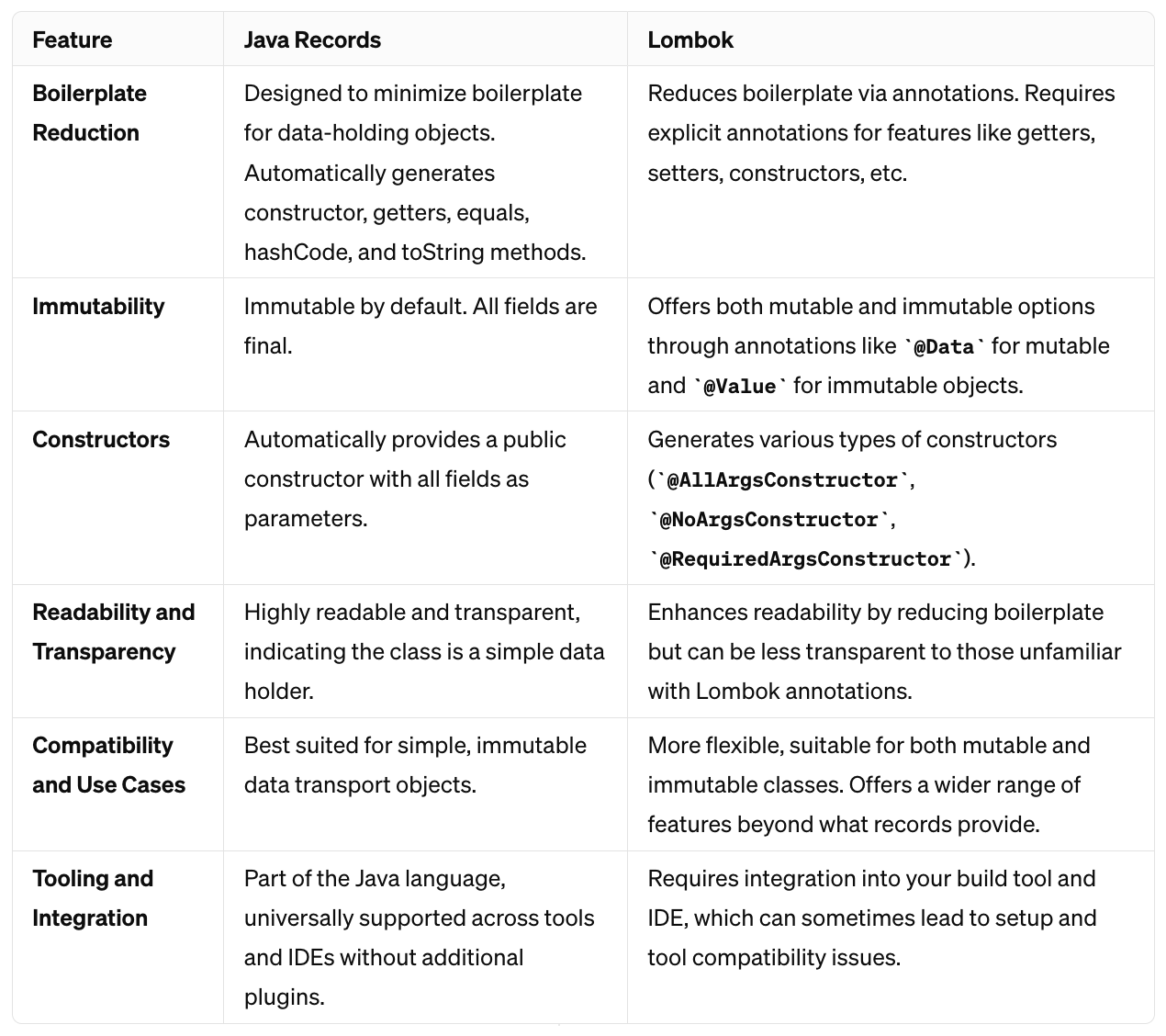🎓 Top 15 Udemy Courses (80-90% Discount): My Udemy Courses - Ramesh Fadatare — All my Udemy courses are real-time and project oriented courses.
▶️ Subscribe to My YouTube Channel (178K+ subscribers): Java Guides on YouTube
▶️ For AI, ChatGPT, Web, Tech, and Generative AI, subscribe to another channel: Ramesh Fadatare on YouTube
In the evolving landscape of Java, developers often seek efficient ways to reduce boilerplate code, particularly for data-holding classes. Two popular approaches are Java Records, introduced in Java 14 (standardized in Java 16), and Project Lombok, an established third-party library. In this blog post, we'll explore the differences and similarities between Java Records and Lombok, using examples to highlight their features and use cases.
What are Java Records?
Java records are a type of class designed for holding immutable data. They automatically provide implementations for methods like equals(), hashCode(), and toString(), significantly reducing boilerplate code. This makes them ideal for creating Data Transfer Objects (DTOs), entities, and other model classes in a Spring Boot application.
Example of Java Record
Let’s consider a simple example of a Java Record representing a Person.
public record Person(String name, int age) {}
In this example, Person is a record with two fields: name and age. Java automatically provides the following for this record:
A public constructor: Person(String name, int age)
Public getter methods: name() and age()
Implementations of equals(), hashCode(), and toString()
Using Getter Methods
One key feature of records is that they provide implicit getter methods for accessing the fields, which are named after the fields themselves.
Here's how you can create an instance of Person and use its getter methods:
public class Main {
public static void main(String[] args) {
Person person = new Person("Alice", 30);
// Using getter methods
String name = person.name();
int age = person.age();
System.out.println("Name: " + name);
System.out.println("Age: " + age);
}
}
Output:
Name: Alice Age: 30
What is Lombok?
Lombok is a Java library that plugs into your editor and build tools. It simplifies your code by generating boilerplate code like getters, setters, constructors, and more through annotations.
Example of Lombok Data Class
import lombok.Data;
@Data
public class Person {
private final String name;
private final int age;
}
The @Data annotation generates all the getters, a useful toString method, and equals and hashCode implementations.
Usage:
Person person = new Person("Alice", 30);
System.out.println(person.getName()); // Alice
System.out.println(person.getAge()); // 30Difference Between Java Records and Lombok
1. Boilerplate Reduction
Java Records
public record User(Long id, String name, String email) {}
This single line automatically generates a constructor, getters, and equals, hashCode, and toString methods.
Lombok
import lombok.Data;
@Data
public class User {
private Long id;
private String name;
private String email;
}
The @Data annotation generates getters, setters, required constructors, and the same methods as records, but you need to include the Lombok library and annotations.
2. Immutability
Java Records
public record User(Long id, String name) {}
// User's fields are final and cannot be changed after creation.
Records are immutable by default.
Lombok
import lombok.Value;
@Value
public class User {
Long id;
String name;
}
// Similar to records, @Value makes fields final and generates only getters.
Lombok can create immutable classes using @Value, but it's not the default behavior.
3. Constructors
Java Records
public record User(Long id, String name) {}
// Implicit constructor: User(Long id, String name)
Records provide an implicit public constructor matching all its fields.
Lombok
import lombok.AllArgsConstructor;
@AllArgsConstructor
public class User {
private Long id;
private String name;
}
// Generates a constructor with all fields: User(Long id, String name)
Lombok requires an @AllArgsConstructor annotation to generate a similar constructor.
4. Readability and Transparency
Java Records
public record User(Long id, String name) {}
Records clearly define their purpose as data carriers.
Lombok
import lombok.Data;
@Data
public class User {
private Long id;
private String name;
}
Lombok enhances readability by reducing boilerplate but can be less transparent to those unfamiliar with its annotations.
5. Compatibility and Use Cases
Java Records
public record UserDTO(Long id, String name) {}Lombok
import lombok.Data;
import javax.persistence.Entity;
import javax.persistence.Id;
@Entity
@Data
public class UserEntity {
@Id
private Long id;
private String name;
}
6. Tooling and Integration
Java Records
Lombok
Conclusion
Java Records and Lombok both aim to reduce boilerplate code in Java, but they approach this goal differently. Records offer a language-level solution focusing on immutability and data transparency, ideal for simple, immutable data objects. Lombok, on the other hand, provides a more flexible annotation-driven approach suitable for a wider variety of use cases.The choice between Java Records and Lombok will depend on your specific needs, preferences, and project complexity. As Java continues to evolve, it will be interesting to see how these two approaches coexist and complement each other in the Java ecosystem.




![[NEW] Full-Stack Java Development with Spring Boot 4 & React Build 5 Spring Boot Projects with Java: Line-by-Line Coding](https://img-c.udemycdn.com/course/750x422/5338984_4d3a_5.jpg)











Comments
Post a Comment
Leave Comment